The first serial Chinese AWACS aircraft
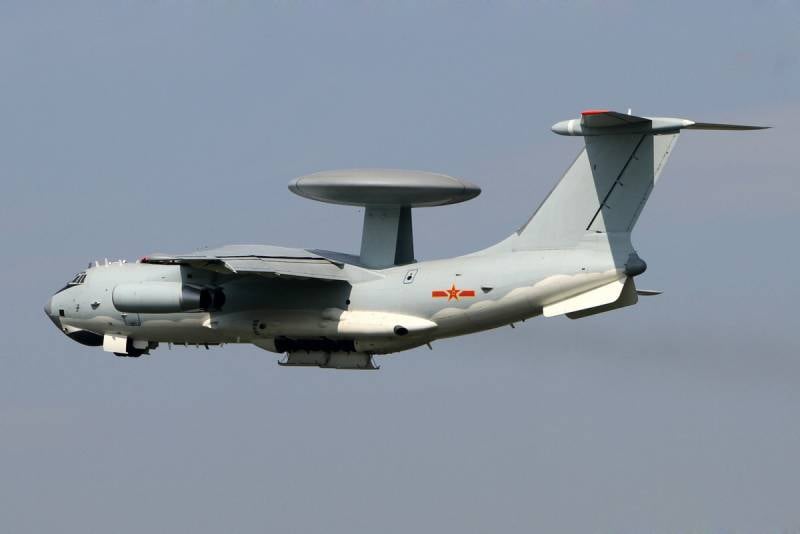
At the end of the 1950th century, the Chinese army lagged far behind the developed countries in terms of the level of equipment with modern equipment and weapons. The land, air and sea forces of the PLA were for the most part equipped with samples created on the basis of Soviet developments of the 1960-1980s. Active military-technical cooperation with the United States and its allies that took place in the XNUMXs provided China with access to a number of advanced foreign defense technologies and even to certain modern weapons at that time, but this did not fundamentally change the situation.
In the 1990s, when Western sanctions were imposed against China after the suppression of student protests in Tiananmen Square, the main supplier of modern weapons for the PLA was Russia. At the same time, relying on the growing economic power and shamelessly copying engineering solutions and technologies, the PRC leadership has relied on the development of its own military-industrial complex.
At the first stage, complex defense products were ordered abroad, at the second stage, on the basis of the received technical documentation, production was established within the country, and then, based on the acquired technologies and accumulated experience, the development of equipment and weapons was carried out, which were declared "originally Chinese."
In fairness, it must be said that the stage when the Chinese military-industrial complex relied on reverse engineering for the most part has already been passed, and the PRC military industry is quite capable of creating most of the modern military products on its own.
Creation of the AWACS aircraft KJ-2000
In the early 1990s, China signed a number of major defense contracts with Russia. In particular, multibillion-dollar deals were made between Moscow and Beijing for the supply of S-300P anti-aircraft missile systems and heavy Su-27SK fighters.
To control the actions of our own fighter-interceptors and issue target designation to long-range anti-aircraft systems of the PLA Air Force, modern long-range radar patrol and control aircraft were required, and our country offered China an export AWACS A-50E aircraft with a simplified radio-technical complex and without closed communication equipment.
After studying the characteristics of the A-50E radio-technical complex, which was built on a not very new element base, Chinese experts rejected this option. As a result, the parties decided to create a “flying radar picket” based on the Il-76 aircraft, equipped with modern Western radio engineering and communications equipment.
In 1997, a Chinese-Russian-Israeli consortium was created, the purpose of which was to build four aircraft of an early warning and control aviation complex for the PLA Air Force. The contractors were the Israeli company Elta and the Russian TANTK them. G. M. Berieva. The Russian side undertook to prepare for conversion the serial A-50 from the presence of the RF Ministry of Defense, and the Israelis were to install the EL / M-205 Phalcoon radar on it. In Russian sources, the A-50 with Israeli equipment is referred to as the A-50I.
Unlike the RTK of the Soviet A-50 aircraft, the Israeli EL / M-205 Phalcoon pulse-Doppler radar, developed for the Chinese A-50I, had a non-rotating mushroom antenna with three AFARs forming a triangle. One APAA consists of approximately 800 active transceiver modules that perform electronic beam scanning in two planes. Three AFARs with a field of view of 120° each provide an all-round view, without mechanical rotation of the fairing. According to Israeli experts, such a scheme greatly simplifies the design of the antenna radome and reduces weight.
According to advertising materials provided by Elta, the relatively low carrier frequency of the decimeter radar (1,2-1,4 GHz), in combination with high-performance computing tools and special noise suppression devices, made it possible to detect "difficult" low-altitude airborne targets, such as cruise missiles and aircraft developed using low radar signature technology.
In addition, the Chinese AWACS aircraft was supposed to carry modern electronic intelligence equipment, which made it possible to listen to enemy radio communications and monitor ground and ship radars in the combat area. The cost of one aircraft with an Israeli RTK was $250 million.
The practical implementation of the A-50I project began in 1999, when the A-50 with tail number 44, taken from the Russian Air Force, after dismantling the standard RTK, flew to Israel to install radar, radio and communications equipment. The transfer of the finished aircraft to the customer was planned in the second half of 2000. But in the summer of 2000, already with the high technical readiness of the complex, the Israeli side announced its withdrawal from the program. This happened due to strong pressure from the United States.
The decision to terminate the contract not only resulted in financial losses, but had a negative impact on Israel's reputation as a reliable arms supplier. At the same time, the Americans managed to only slightly slow down the implementation of the Chinese AWACS aircraft program, but not completely disrupt it. It is worth saying that Elta used the developments received under the Chinese contract, having concluded an agreement with India in 2004 for the supply of three A-50EI aircraft. The total amount of the deal was $1,1 billion, with about 2/3 of the cost being Israeli equipment.
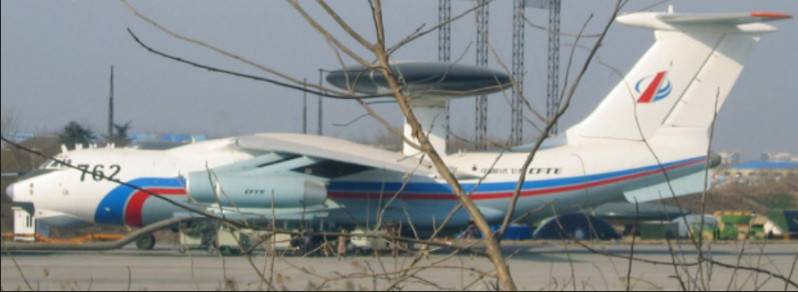
The aircraft, prepared for the installation of Israeli equipment, was returned to the PRC, after which the Chinese leadership decided to equip the Il-76TD transport vehicles purchased in Russia with a nationally developed radio-technical complex.
There is an unofficial opinion that a secret deal between Israel and China nevertheless took place, and Chinese specialists received documentation for the EL / M-205 Phalcoon radar. An indirect confirmation of this is the fact that the equipment of the AWACS aircraft, which received the designation KJ-2000 (“Kun Ching” - “Heavenly Eye”), largely repeated the Israeli complex. As planned from the very beginning, a radar with AFAR in a fixed disk-shaped fairing was installed on the aircraft.
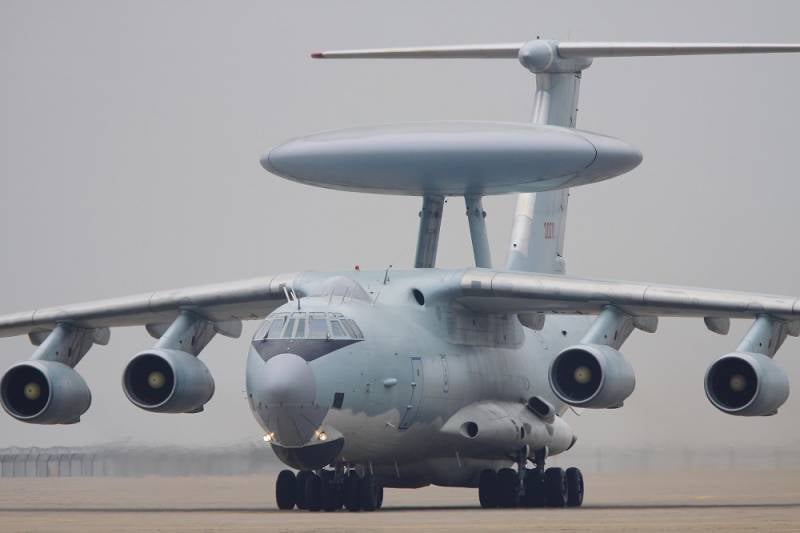
During operation, three fixed antenna modules installed inside the fairing and providing a circular view of the airspace were cooled by outside air entering through special openings. The frequency range of the Type 1475 radar is divided into 22 operating frequencies. A triangle is drawn in the upper part of the radar fairing, corresponding to the location of the AFAR flat panels.
The radar developed at the Nanjing Research Institute No. 14 is capable of detecting high-altitude targets at a distance of more than 400 km and simultaneously tracking up to 100 air and surface targets. It is reported that during the tests it was possible to detect and accompany the H-6 bomber (a Chinese copy of the Tu-16), flying in a parallel course at a distance of 470 km. Also, RTK operators were able to see a launching ballistic missile at a distance of 1 km.
There is a satellite communication antenna in the upper front part of the fuselage of the KJ-2000 AWACS aircraft, which allows real-time transmission of information. Unlike the Soviet AWACS A-50 aircraft, the KJ-2000 does not have side flat antennas of an electronic intelligence station and an air refueling system boom.
Nothing is known about the characteristics of the equipment that broadcasts information to ground command posts, but the Chinese media claim that one KJ-2000 is capable of simultaneously controlling the actions of several dozen combat aircraft. This became possible thanks to the use of a new computing complex based on the Chinese Spirit Chip processor.
Apparently, for its time, the KJ-2000 had a fairly advanced on-board radio-electronic equipment, and the output of radar information was carried out on color LCD monitors.
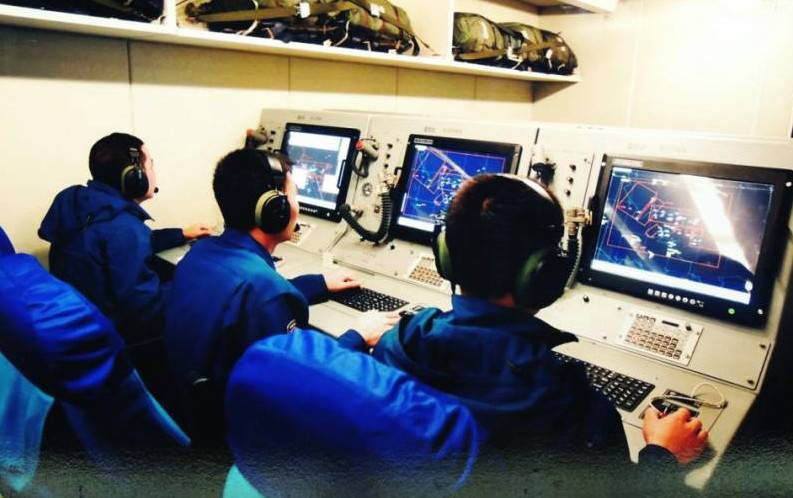
The crew can be 12-15 people, of which the flight crew is 5 people. The aircraft carries out patrols at an altitude of 5–000 m. The maximum speed is 10 km/h. Cruising - 000 km / h. Flight range - 840 km. Flight duration - 780 hours 5 minutes. Operation requires a runway with a length of at least 000 m.
At a distance of 2 km from its airfield, an aircraft can remain on patrol for 000 hour and 1 minutes. For the personal protection of the aircraft, the following equipment is installed on board: a missile launch warning system, chaff and IR traps.
Aircraft AWACS KJ-2000
The installation of the Chinese RTK on the Il-76TD purchased in Russia began in 2002. Xi'an Aircraft Company (XAC) in Xi'an was appointed as the prime contractor responsible for the creation of the KJ-2000 AWACS aircraft. The KJ-2000 made its first flight in November 2003.
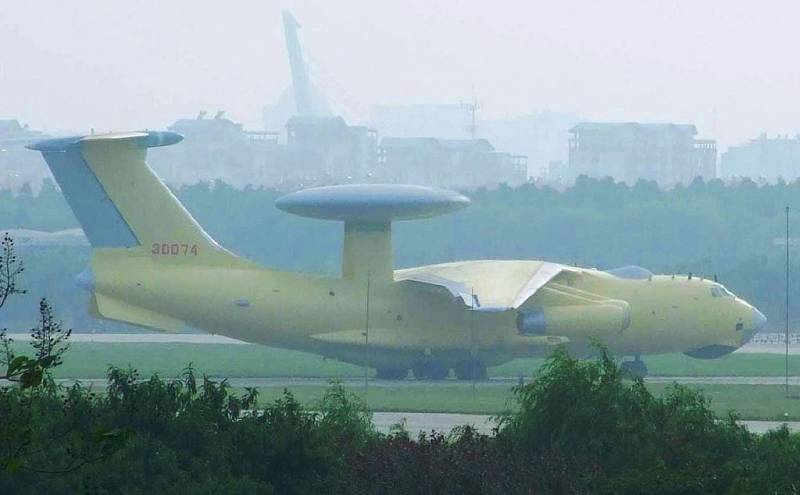
Military tests of the radar complex began in 2004 in the southwest of the country. The transfer of the last fourth KJ-2000 aircraft to the customer took place in 2008.
After the successful completion of tests in November 2006, the KJ-2000 long-range radar patrol and control aircraft entered service with the PLA Air Force. According to American data, all aircraft were brought together in the specially formed 76th AWACS Regiment, organizationally part of the 26th Special Forces Division of the PLA Air Force.
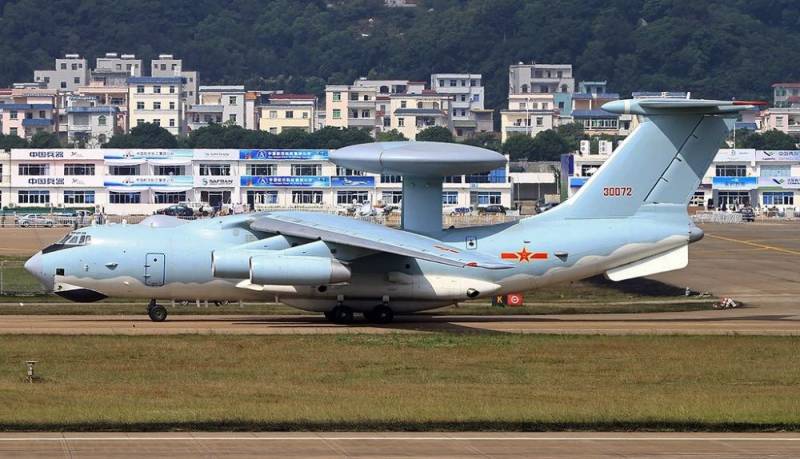
The place of permanent deployment of all KJ-2000 AWACS aircraft was the Wuxi airfield in Jiangsu province, west of Shanghai. The terminals of the international airport are located in the northern part of this dual-use airfield. In the southern part of the Wuxi airfield, which is run by the military, four large hangars have been erected that can accommodate such a large aircraft as the Il-76.
However, the KJ-2000 aircraft did not stand idle at the home airfield, but actively participated in various exercises, in testing new types of missiles and combat aircraft, and also patrolled the airspace along the Formosa Strait, border areas with India and Vietnam. For this, the flight and technical staff of the 76th AWACS regiment, together with the airfield infrastructure, was transferred to other airfields, where all four KJ-2000s, as well as individual vehicles of the 76th Aviation Regiment, could be deployed along with transport support aircraft.
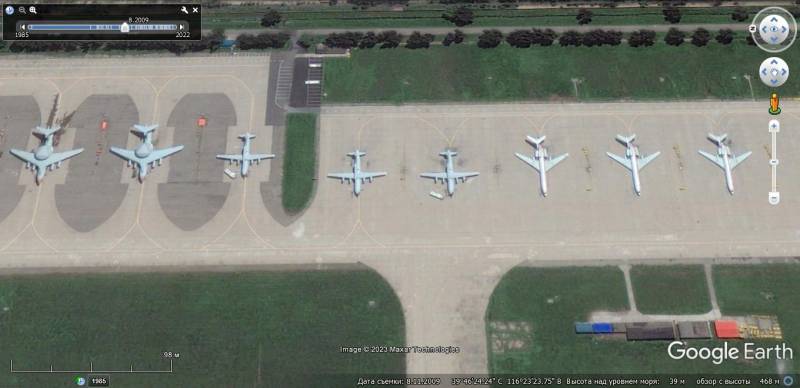
Satellite image of Google Earth: aircraft KJ-2000, KJ-200 and Tu-154MD at Nanyuan airbase, the picture was taken in August 2009
Based on the freely available satellite images of Google Earth, one can judge the geography of the deployment of KJ-2000 aircraft. So, in the picture of the Nanyuan airbase, located in the suburbs of the Chinese capital, the KJ-2000, KJ-200 and Tu-154MD AWACS aircraft are visible in all their glory, which in August 2009 participated in the major exercises of the PLA Air Force and Navy held in the Bohai Gulf and Yellow sea.
The KJ-2000 aircraft were not rare guests at the Dingxing airbase in northwest China in the Gansu province, the Inner Mongolia region, where the PLA Air Force combat center and the largest in China are located. aviation and a missile range.
In March 2006, a large-scale demonstration of modern aircraft and air defense systems was organized for the top military and political leadership of the PRC at the Dingxin airbase. Among other samples, the KJ-2000 AWACS aircraft occupied a place of honor in the exposition.
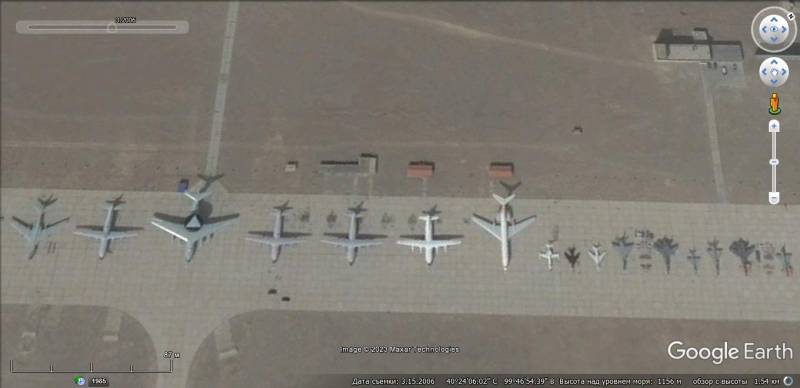
Satellite image of Google Earth: KJ-2000 aircraft at Dingsin airbase among other aircraft, the image was taken in March 2006
The great advantage of the Dingsin range is the ability to carry out launches at air targets with long-range anti-aircraft and aviation missiles, since this area is practically not populated, and in the east it is about 600 km to the nearest settlement of Bayan-Nur. This allows you to conduct secret tests away from prying eyes and ensure the necessary safety of flights and the use of aviation weapons.
Large-scale exercises of the PLA Air Force "Red Sword", as well as the final stage of the competition of fighter pilots "Golden Helmet" are regularly held at the aviation training ground. At the final stage of the competition in close air combat, the J-10, J-11, Su-30MKK and Su-35SK fighters converge.
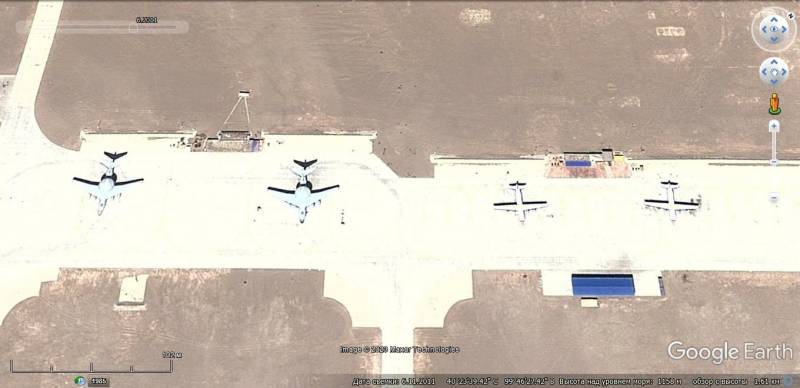
Satellite image of Google Earth: KJ-2000 aircraft at Dingsin Air Base, image taken in June 2011
In the past, the first Chinese KJ-2000 AWACS aircraft were regularly used to monitor the progress of air battles and organize radar support.
Between exercises, tests and patrols, the KJ-2000 aircraft underwent maintenance and repair at the Xi'an factory airfield of the XAS aircraft manufacturer.
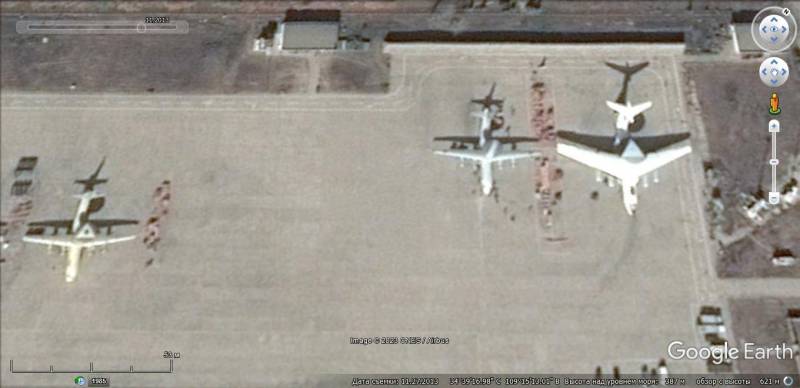
Satellite image of Google Earth: the KJ-2000 aircraft next to other AWACS aircraft in the parking lot of the Xi'an factory airfield, the image was taken in November 2013
Shortly after the commissioning of all four KJ-2000s, the PLA command expressed interest in acquiring an additional batch of such aircraft, equipped with improved on-board equipment and electronic intelligence equipment. However, everything rested in the absence of new basic Il-76 aircraft, which were not assembled in Russia in those years, and the customer refused to purchase used transport aircraft from the Russian Air Force.
In 1995, an attempt was made to continue building the upgraded Il-76MF at the Tashkent Aviation Plant, but it failed. In July 2006, the Russian government issued an order to organize the production of Il-76 aircraft in Ulyanovsk at the Aviastar-SP plant. But the production of Il-76MD-90A aircraft with PS-90A3 engines was delayed, and the Chinese side lost interest in this project.
The decommissioning of the lead aircraft KJ-2000 took place in 2009, and now it is installed as a monument in the museum and memorial complex at the Xi'an factory airfield. In 2018, all KJ-2000s were withdrawn from the combat strength of the PLA Air Force.
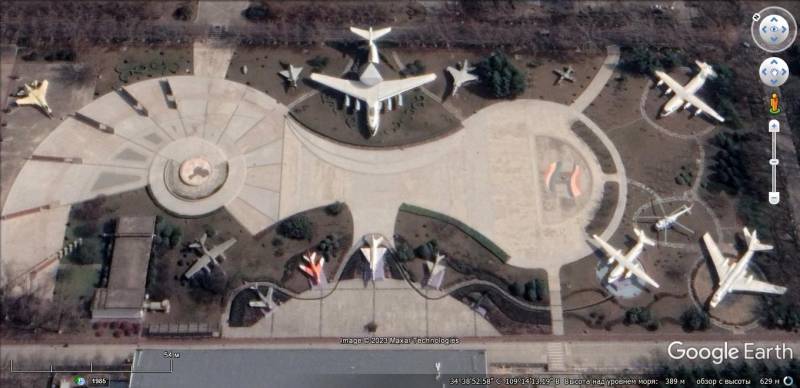
Google Earth satellite image: KJ-2000 aircraft in the museum and memorial complex at the XAS factory airfield in Xi'an
From the three remaining KJ-2000s, the radar antenna and the radio engineering complex were dismantled, after which the “disarmed” Il-76TD were used as flying laboratories for several years.
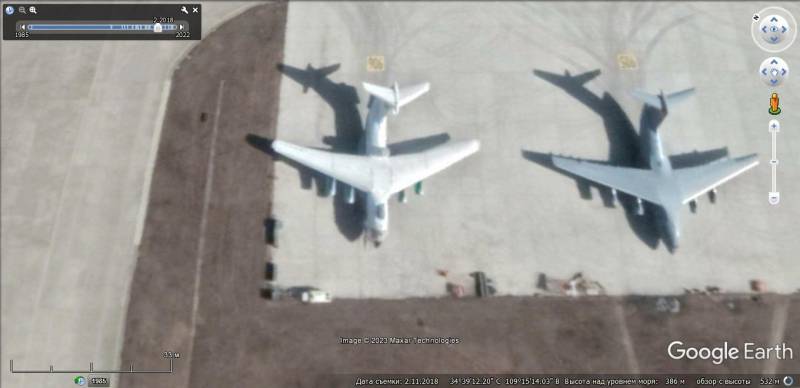
Satellite image of Google Earth: Il-76TD (former KJ-2000) and Y-20 aircraft at Xi'an airfield
The Il-76TD, which served as the base for AWACS aircraft, is easily identified by the satellite communications antenna located in the upper front of the fuselage and the base for the radar antenna pylon that has not been dismantled. Apparently, at the moment all these machines have already been decommissioned.
Although AWACS aircraft, with proper maintenance and repair, could serve for at least another 10 years, the PLA Air Force command decided to abandon them. Most likely, this is due not to the low fuel efficiency of the D-30KP-2 aircraft engines, as they say on Chinese forums, but to other reasons. From 2009 to 2020, China purchased 463 D-30KP-2 engines for Il-76MD/TD, Il-78, KJ-2000, H-6K aircraft and the first Y-20 prototypes.
Apparently, the refusal of the KJ-2000 is explained by the need for expensive refurbishment of heavily worn-out aircraft and the Type 1475 radar complex as a result of intensive operation. From the very beginning of its service, the absence of an air refueling system on this aircraft was considered a major drawback in the air with fuel on board.
The main factor that influenced the premature write-off of the KJ-2000 is the mass production of Chinese AWACS aircraft based on the Y-8 and Y-9 (Chinese versions of the An-12), which, being equipped with more economical turboprop engines, turned out to be much less expensive to manufacture. and operation, and required shorter runways.
Prospects for the creation in China of a new heavy aircraft AWACS KJ-3000
Aircraft KJ-200, KJ-500, ZDK-03 and Y-8G will be considered in the next part of the review, dedicated to Chinese early warning aviation. But at the end of this publication, we will analyze a promising heavy AWACS aircraft that can replace the KJ-2000.
After the transfer of the first batch of Y-2016 heavy military transport aircraft to the PLA Air Force in 20, publications began to appear in specialized aviation publications that talked about the possibility of an early creation of tanker aircraft and AWACS at the new base.
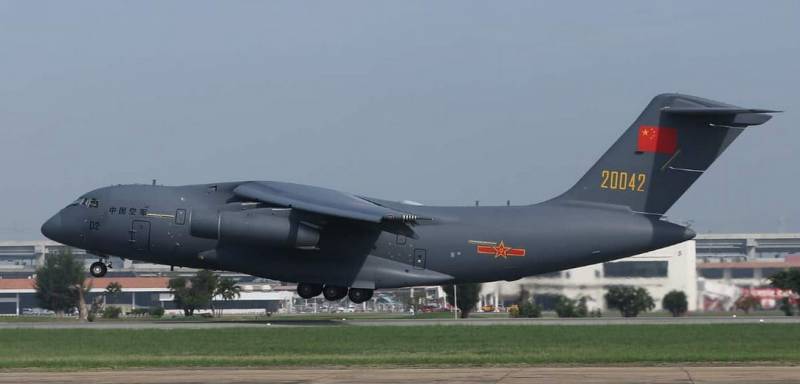
Heavy military transport aircraft Y-20
The Y-20 military transport aircraft has a maximum takeoff weight of 220 kg and can carry 000 kg. Flight range with a load of 66 kg - 000 km. Maximum flight speed - 64 km / h, cruising - 000 km.
The first prototypes were powered by four Russian D-30KP-2 engines. Serial cars received a Chinese-made WS-18 turbofan engine with a maximum thrust of 122 kN each. From 2021, it was planned to install more powerful and economical WS-20 engines, but it is not known if this was realized.
In 2020, the creation of the Y-20U tanker aircraft was confirmed, which should support the actions of the new KJ-3000 heavy AWACS aircraft and H-20 stealth bombers.
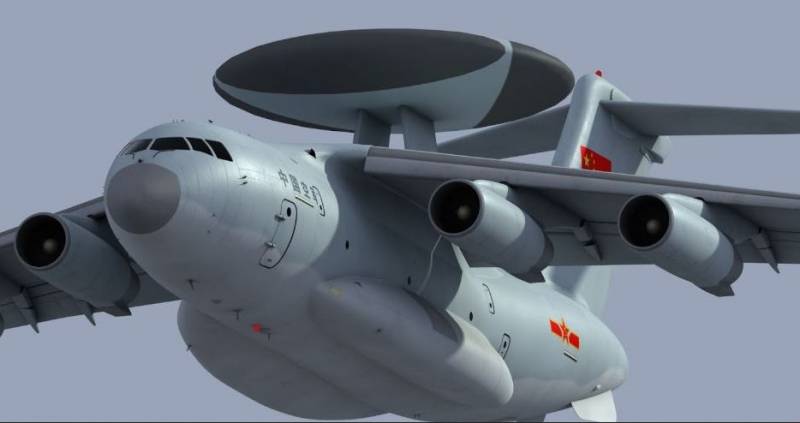
One of the options for the alleged appearance of the KJ-3000 AWACS aircraft with an upper antenna
Initially, Chinese and Western publications wrote that the new KJ-3000 AWACS aircraft will have the same layout as the KJ-2000 - with a non-rotating AFAR antenna dish mounted on a pylon in the middle upper part of the fuselage.
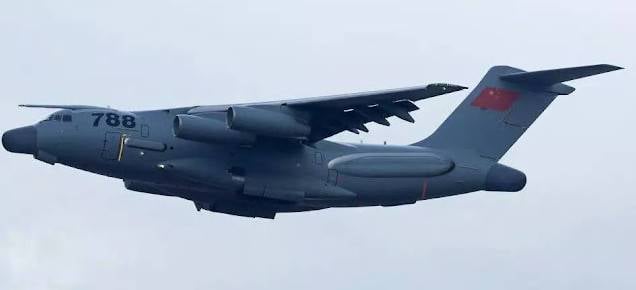
One of the options for the proposed appearance of the KJ-3000 AWACS aircraft with a spaced antenna arrangement
However, last year, allegedly on the basis of leaks made by the XAS company involved in the creation of this aircraft, drawings appeared on the network with the alleged appearance of the KJ-3000.
The new version has four spaced radar antennas: one each in the tail and nose, and two on the sides of the fuselage. The scheme with antenna diversity is more difficult to implement, but it is preferable in terms of reducing the aerodynamic drag of the aircraft, which, of course, will have a positive effect on increasing patrol time.
To be continued ...
Information